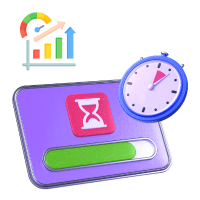
So, how much work time is there in a calendar? The question is simple. However, the answer is anything but simple. Now, we all know the basics that the annual work hours are 2080 based on the 40 work hours/week standardization in the USA for full-time employees. However, what about part-time and other types of work contracts?
Plus, don’t forget the PTOs and holidays, which you need to compensate employees for. Another doubt is why we need to determine the working hours in a year. To give you a straightforward answer, it helps you better understand your earnings. Plus, there are some other strong reasons as well, which we will cover here.
So, in today’s blog, we will help you calculate how many work hours in a year. Plus, we will cover some benefits of figuring out your work time in a year, and more. So, let’s dive right into it.

How Many Working Hours Are in a Year?
Generally, there are 2080 work hours in a year according to the standard 40-hour workweek. Here’s how we calculated it:
- 40 Work Hours * 52 Weeks = 2080 Annual Work Hours
Other factors impacting this calculation include:
- Work schedules
- Time off
- Holidays
- Overtime
However, this may fluctuate based on whether it’s a leap year or not. If that’s the case, there can be up to 2096 work hours based on 260-262 weeks in that year.
Read Also: Top 13 Best Habit Tracker Apps for Business and Personal Use in 2025
Work Hours in Other Brackets
Make your workday more productive
Time tracking and work management can help you reach your goals
faster.
Wondering how many work hours are in other brackets? Here’s a breakdown for monthly, quarterly, and lifetime work hours.
1. Average Monthly Work Hours
One month has 19-22 work hours, depending on the calendar and length. Presuming that a month has 4 weeks, here’s the formula.
- 40 Weekly Hours * 4 Monthly Weeks = 160 Monthly Work Hours
2. Average Quarterly Work Hours
Again, presuming that a month has 4 weeks and a quarter is 3 months. Usually. Here’s the formula.
- 40 Weekly Hours * 12 Quarterly Workweeks = 480 Quarterly Work Hours
3. Average Lifetime Work Hours
According to an expert survey, 61 happens to be the retirement age on average. However, some people also retire at 65. Presuming that you have started working at the age of 20 years old, you will work till you are about 60 years old:
- 40 Weekly Hours * 52 Annual Weeks = 83200 Lifetime Work Hours
Work Hours Vs. Non-Work Hours

Working hours in a year are the time you spend on employment-related activities. Unlike this time, non-working time is usually for taking rest or hobbies. Here’s a general breakdown.
| Aspect | Work Hours | Non-Work Hours |
| Definition | Time spent at a job | Any time but working hours |
| Dedicated To | Employment-related activities | Non-work-related activities |
| Examples | Meetings, internal training sessions, work tasks | Rest, hobbies, time with family, and social gatherings |
To calculate non-working hours, you need this formula.
- 40 Weekly Hours: 8760 Yearly Hours – 2080 Yearly Work Hours = 6680 Yearly Non-Work Hours.
Also, here are a few more important things you need to remember.
- Short rest periods, such as coffee or snack breaks, come under compensable work-time.
- Lunch breaks, however, are not considered work time, and employees don’t generally get paid for them, unless specified in the state regulations.
- If you compare your work and non-work hours, you can easily find out burnout risks, boost productivity, and improve work-life balance. To make it simple, figure out the percentage of the year you spent working.
For Instance, for 40 Weekly Hours = 2080 / 8760 * 100 = 23.7% of the Year Spent Working.
Non-Traditional Work Hours
The working hours in a year, if you are not working the traditional 40 hours/week, can be any. For example, if you are working part-time or in a sector with longer work hours, such as law or finance, the average yearly work hours will change. Here are a few calculations for a better understanding.
- 20 Weekly Work Hours = 20 * 52 = 1040 Annual Work Hours (about 12% of the year spent working)
- 50 Weekly Work Hours = 50 * 52 = 2600 Annual Work Hours (about 30% of the year spent working)
- 60 Weekly Work Hours = 60 * 52 = 3120 Annual Work Hours (about 36% of the year spent working)
Read Also: Top 35 Ways to Improve the Work Performance of Your Employees in 2025
How to Calculate Work Hours Per Year
To accurately determine how many work hours in a year, you need to know that regardless of the work schedule, you never work all those hours per year. With that being said, here’s what you need to account for.
- Vacation Days: The PTO and non-PTO days you took as vacation.
- Sick Days: The PTO and non-PTO you took when you were not feeling well.
- Holidays: The days off your organization provides for observing the 11 public holidays.
So, to find out your annual working hours, you first need the total work hours per year. Then, all you have to do is subtract any PTO, non-PTO, and holidays from them. Here’s the final formula for this blog.
- 2080 – [{PTO + Non-PTO + Holidays} * 8] = Total Hours You Worked in that Year
Automate Time Tracking with DeskTrack
With DeskTrack’s automated time tracking features, there is no need for heavy calculations. Save time and focus on what matters the most. It provides you with real-time attendance tracking data, so you will know at any time how many employees have clocked in, clocked out, and are on leave. You can also view this data for the month or even the year for your individual employees, teams, departments, and even the whole organization. The employee monitoring software even takes half days into account. Try now and you will know why organizations across 100+ countries have implemented it already.
Frequently Asked Questions (FAQ)
Q. How Many Working Hours Are in a Year?
Ans. Generally, there are 2080 work hours in a year according to the standard 40-hour workweek. However, this may fluctuate based on whether it’s a leap year or not. If that’s the case, there can be up to 2096 work hours based on 260-262 weeks in that year. Other factors impacting this calculation include work schedules, time off, holidays, and overtime.
Q. Do 2080 Working Hours in a Year Include Holidays?
Ans. No 2080 hours/year don’t include holidays and PTOs. That’s due to the FLSA not needing employers to provide paid time off for holidays, vacations, or sick leave.
Q. What are the Factors Influencing How Many Work Hours in a Year?
Ans. These aspects heavily impact the number of hours you work in a year.
- Work Flexibility
- Work Contracts
- Work Performance Improvement
- Type of Work
Q. How to Calculate Work Hours Per Year?
Ans. Here’s what you need to do.
- Multiply the Work Hours by 52
- Calculate PTO & Holidays
- Multiply the Work Hours You Took Off by PTO & Holiday Hours
- Subtract Time Off from Per-Year Work Hours
Q. What are the Benefits of Knowing How Many Work Hours in a Year?
Ans. These are the advantages you will get.
- Estimate Your Annual Income
- Quality Work-Life Balance
- Labor Law Compliance
- Valuable for Your HR Department
- Increased Productivity








